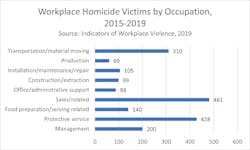It's a very grim statistic. From 1992-2019 workplace violence has killed almost 18,000 people.
This number comes from a recent study conducted by NIOSH, the Bureau of Justice Statistics, and the Bureau of Labor Statistics provides a broad view of workplace violence in the United States during the 27 years from 1992 to 2019. they define workplace violence as incidents that occurred outside the workplace but stemmed from work-related issues.
Looking specifically at 2019, the most recent year included in the study, the total of 454 homicides represents a 58% decrease from the high of 1,080 in 1994 but also an 11% increase since 2014. Homicides as a percentage of total fatal occupational injuries fell from 17% in 1993 to 8.5% in 2019.
More than 40% of workplace homicides in this period occurred in public buildings such as convenience stores and office buildings. Most other workplace homicides took place on streets, in private residences, and on industrial premises.
For non-fatal incidents of workplace violence, during 2015–2019 the average annual rate was 8 per 1,000 workers. Law enforcement and security professionals had the highest average annual victimization rate at 77.5 per 1,000 workers, followed by mental health professionals (45.2 per 1,000) and medical professionals (15.1 per 1,000). For workers in corrections professions, a subcategory of law enforcement and security, the victimization rate was 149.1 per 1,000.
During 2015–2019, the occupations with the highest incidence of workplace homicides were sales, protective service (police and firefighters), and transportation (see chart).
To help understand the issue the report provides data structured around 13 key “indicators” such as the characteristics of victims of workplace violence, characteristics of offenders, the use of weapons, the treatment of nonfatal injuries in emergency departments, and socio-economic problems that result from workplace violence.
Available on the website of the Bureau of Justice Statistics, the study "Indicators of Workplace Violence, 2019" draws on five nationally representative data sources, including the Census of Fatal Occupational Injuries, the Survey of Occupational Injuries and Illnesses, the National Crime Victimization Survey, the National Electronic Injury Surveillance System, and the National Vital Statistics System.

